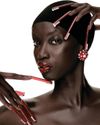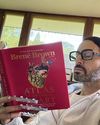
At a recent party in SoHo, I was surrounded by flirty Gen Z’ers and Cali-sober younger millennials. The looks were ferocious, with skin showing all-round, from itty-bitty skirts to curve-skimming dresses and crop tops galore— and, amid the throbbing electro and all that skin, I spotted one young woman wearing a dainty corset, laced up at the front. I couldn't stop myself from asking her about it. T love the corset for all sorts of structural and flattering reasons,” replied Lizzy Cohan, a 26-year-old journalism student. She bought this one after she saw the lead singer of a favorite band, the Marias, wearing something similar, and tracked down Christina Montoya, the designer of the California-based brand Stiina. A DM later and measurements sent, Cohan had her corset, which at this party she wore with wide-leg cargos.
Years ago, of course, the corset was something that constrained not just physically but psychologically. In the Victorian era, it created the wasp waist on women, transforming even an expansive midsection into a tiny concave triangle. The effects of long-term wear were extreme: organs were shifted; simply breathing could be a challenge. For these reasons—along with fashion charting a course toward the freedom and social scandale) of flappers—the corset has been, for more than a century, a kind of sartorial Debbie Downer.
この記事は Vogue US の November 2022 版に掲載されています。
7 日間の Magzter GOLD 無料トライアルを開始して、何千もの厳選されたプレミアム ストーリー、9,000 以上の雑誌や新聞にアクセスしてください。
すでに購読者です ? サインイン
この記事は Vogue US の November 2022 版に掲載されています。
7 日間の Magzter GOLD 無料トライアルを開始して、何千もの厳選されたプレミアム ストーリー、9,000 以上の雑誌や新聞にアクセスしてください。
すでに購読者です? サインイン

FINAL CUT
\"WE WANT YOU TO GO FOR IT!\" ANNA TOLD ME

SCREEN TIME
Three films we can't wait to see.

Impossible Beauty
Sometimes, more is more: Surreal lashes and extreme nails put the fierce back in play

Blossoms Dearie
Dynamic, whimsical florals and the humble backdrops of upstate New York make for a charming study in contrasts.

HOME
Six years ago, Marc Jacobs got a call about a house designed by Frank Lloyd Wright. Making it his own, he writes, would be about love, commitment, anxiety, patience, struggle, and, finally, a kind of hard-fought, hard-won peace.

GIRL, INTERRUPTED
Anna Weyant found extraordinary fame as an artist before she had reached her mid-20s. Then came another kind of attention. Dodie Kazanjian meets the painter at the start of a fresh chapter

ROLE PLAY
Kaia Gerber is someone who likes to listen, learn, read books, go to the theater, ask questions, have difficult conversations, act, perform, transform, and stretch herself in everything she does. That she's an object of beauty is almost beside the point.

CALLAS SHEET
Maria Callas's singular voice made her a legend on the stage. In a new film starring Angelina Jolieand on the runwaysthe romance continues.

BOOK IT
A preview of the best fiction coming

GLOBAL VISTAS
Three new exhibitions offer an expansive view.